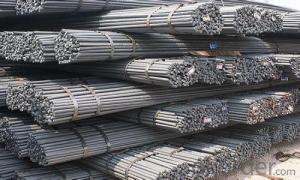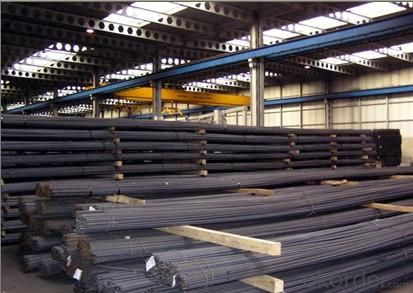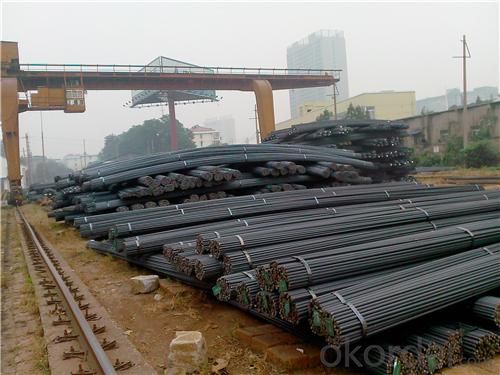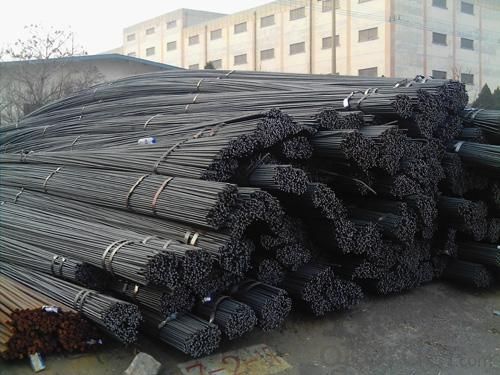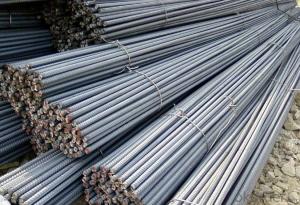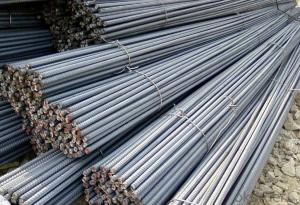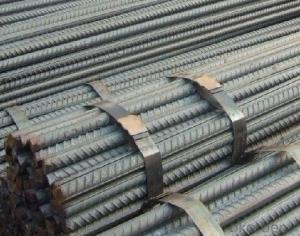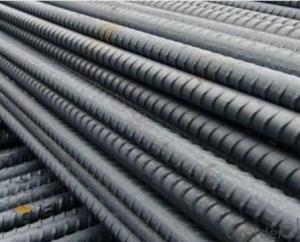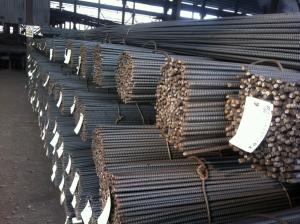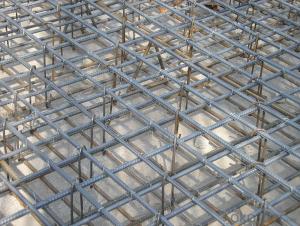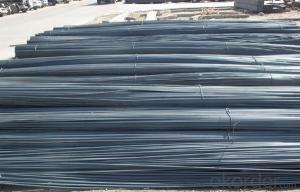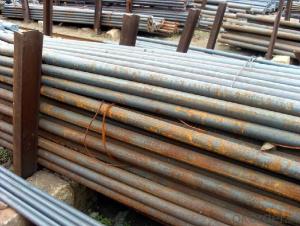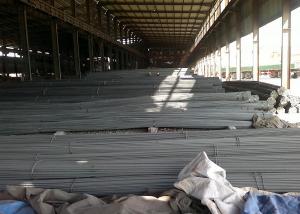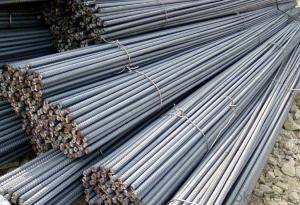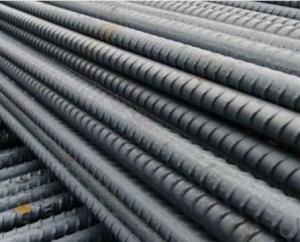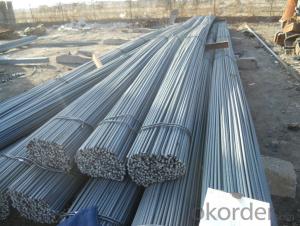ASTM deformed steel bar for construction
- Loading Port:
- Tianjin
- Payment Terms:
- TT OR LC
- Min Order Qty:
- 25 m.t.
- Supply Capability:
- 10000 m.t./month
OKorder Service Pledge
OKorder Financial Service
You Might Also Like
Product Description:
Specifications of HRB400 Deformed Steel Bar:
Standard | GB | HRB400 | |
Diameter | 6mm,8mm,10mm,12mm,14mm,16mm,18mm,20mm, 22mm,25mm,28mm,32mm,36mm,40mm,50mm | ||
Length | 6M, 9M,12M or as required | ||
Place of origin | Hebei, China mainland | ||
Advantages | exact size, regular package, chemical and mechanical properties are stable. | ||
Type | Hot rolled deformed steel bar | ||
Brand name | DRAGON | ||
Chemical Composition: (Please kindly find our chemistry of our material based on HRB500 as below for your information)
Grade | Technical data of the original chemical composition (%) | ||||||
C | Mn | Si | S | P | V | ||
HRB400 | ≤0.25 | ≤1.60 | ≤0.80 | ≤0.045 | ≤0.045 | 0.04-0.12 | |
Physical capability | |||||||
Yield Strength (N/cm²) | Tensile Strength (N/cm²) | Elongation (%) | |||||
≥400 | ≥570 | ≥14 | |||||
Theoretical weight and section area of each diameter as below for your information:
Diameter(mm) | Section area (mm²) | Mass(kg/m) | Weight of 12m bar(kg) |
6 | 28.27 | 0.222 | 2.664 |
8 | 50.27 | 0.395 | 4.74 |
10 | 78.54 | 0.617 | 7.404 |
12 | 113.1 | 0.888 | 10.656 |
14 | 153.9 | 1.21 | 14.52 |
16 | 201.1 | 1.58 | 18.96 |
18 | 254.5 | 2.00 | 24 |
20 | 314.2 | 2.47 | 29.64 |
22 | 380.1 | 2.98 | 35.76 |
25 | 490.9 | 3.85 | 46.2 |
28 | 615.8 | 4.83 | 57.96 |
32 | 804.2 | 6.31 | 75.72 |
36 | 1018 | 7.99 | 98.88 |
40 | 1257 | 9.87 | 118.44 |
50 | 1964 | 15.42 | 185.04 |
Usage and Applications of HRB400 Deformed Steel Bar:
Deformed bar is widely used in buildings, bridges, roads and other engineering construction. Big to highways, railways, bridges, culverts, tunnels, public facilities such as flood control, dam, small to housing construction, beam, column, wall and the foundation of the plate, deformed bar is an integral structure material. With the development of world economy and the vigorous development of infrastructure construction, real estate, the demand for deformed bar will be larger and larger..
Packaging & Delivery of HRB400 Deformed Steel Bar:
Packaging Detail: products are packed in bundle and then shipped by container or bulk vessel, deformed bar is usually naked strapping delivery, when storing, please pay attention to moisture proof. The performance of rust will produce adverse effect.
Each bundle weight: 2-3MT, or as required
Payment term: TT or L/C
Delivery Detail: within 45 days after received advanced payment or LC.
Label: to be specified by customer, generally, each bundle has 1-2 labels
Trade terms: FOB, CFR, CIF
Deformed Steel Bar in container
Deformed Steel Bar in factory
Note:
1. Our products are produced according to national standard (GB), if not, supply according to national standards (GB) or agreement as customer required.
2. Other Grade and Standard Deformed Steel Bar we can supply:
Grade: GR40/GR60, G460B/B500A/B500B/B500C,BST500S
Standard: ASTM, BS, DIN
The Minimum Order Quantity of these products is high, and need to be confirmed.
3. We can not only supply Deformed Steel Bar; if you need anything about building materials, please contact us for further information.
4. Please send us your detail specifications when inquire. We will reply to you as soon as possible. We sincerely hope we can establish a long stable business relationship.

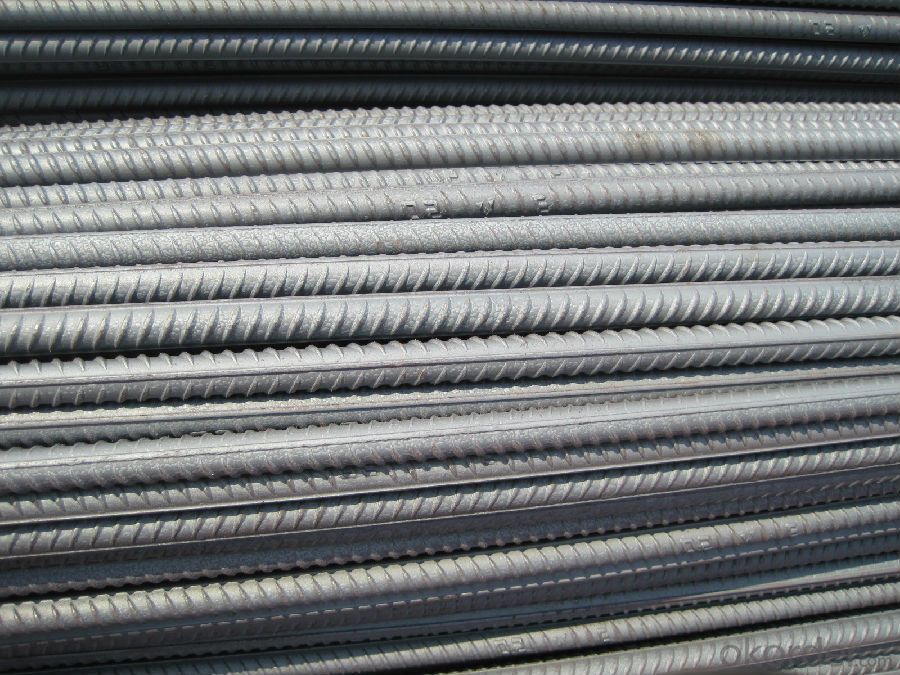
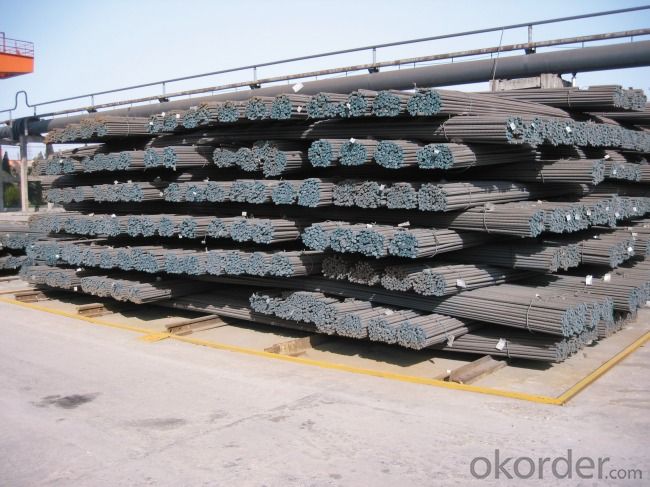
- Q: How do steel rebars resist alkali-silica reaction in concrete?
- Steel rebars resist alkali-silica reaction in concrete primarily due to their passive film and the alkaline environment of the concrete. When steel rebars are embedded in concrete, they form a passive film on their surface. This film acts as a protective layer that prevents direct contact between the steel and the aggressive alkali-silica reactive aggregates present in the concrete. This passive film is formed due to the high pH of the alkaline environment created by the cement in the concrete, which typically ranges between pH 12-13. This high pH helps in creating a protective oxide layer on the surface of the steel rebar, preventing it from coming into contact with the reactive elements in the aggregates. Furthermore, the alkaline environment of the concrete helps in maintaining the passivity of the steel rebars. The alkalinity of the concrete allows the passive film to remain stable and intact, providing a continuous barrier against the alkali-silica reaction. As long as the pH of the concrete remains high, the steel rebars will continue to resist the reaction. It is worth noting that the thickness and quality of the passive film on the steel rebars are crucial in ensuring their resistance to alkali-silica reaction. Any factors that can compromise the integrity of this film, such as carbonation or chloride contamination, may increase the risk of the reaction occurring. In summary, steel rebars resist alkali-silica reaction in concrete due to the presence of a passive film on their surface, which is formed by the alkaline environment of the concrete. This film acts as a protective barrier, preventing the steel from coming into direct contact with the reactive aggregates and thus, mitigating the likelihood of the reaction occurring.
- Q: Can steel rebars be used in cold weather conditions?
- Yes, steel rebars can be used in cold weather conditions. Steel is known for its durability and strength, making it a suitable material for construction projects even in cold climates. However, it is important to take certain precautions when using steel rebars in cold weather. For instance, the rebars should be properly stored and protected from moisture to prevent rusting. Additionally, the concrete mix used with the rebars should be adjusted to ensure it can withstand freezing temperatures and avoid cracking. Overall, with proper planning and precautions, steel rebars can be effectively used in cold weather conditions.
- Q: How do steel rebars affect the overall longevity of a structure?
- Steel rebars, also known as reinforcement bars, play a crucial role in enhancing the overall longevity of a structure. By providing strength and durability, rebars reinforce the concrete, making it more resistant to cracking and structural failure. This reinforcement ensures that the structure can withstand various external forces, such as extreme weather conditions, seismic activity, and heavy loads. Consequently, the use of steel rebars significantly extends the lifespan of a structure, ensuring its long-term stability and safety.
- Q: How do steel rebars affect the overall stability of concrete structures?
- Steel rebars play a crucial role in enhancing the overall stability of concrete structures. By providing tensile strength to concrete, rebars prevent cracks and failure caused by bending or stretching forces. The combination of steel and concrete creates a formidable bond that increases the structural integrity and resistance to various loads, ultimately ensuring the stability and durability of the concrete structure.
- Q: Can steel rebars be used in offshore oil and gas platforms?
- Offshore oil and gas platforms can indeed utilize steel rebars. Steel rebars are widely employed in construction projects to fortify concrete structures, and offshore platforms are no exception. These platforms face diverse environmental and operational factors, including wave loads, wind forces, and seismic activities. By utilizing steel rebars, the structural integrity of the platforms can be bolstered, thereby enhancing overall stability. Nevertheless, it is of utmost importance to use corrosion-resistant steel rebars in offshore applications due to the harsh marine environment. The presence of saltwater, humidity, and exposure to chemicals can expedite the corrosion process. Hence, it is common practice to opt for stainless steel rebars or epoxy-coated rebars for offshore platforms, ensuring long-term durability and preventing corrosion-related complications. Moreover, it is imperative to adhere to pertinent industry standards and regulations when employing steel rebars in offshore oil and gas platforms. These standards stipulate specific requirements for material selection, fabrication, installation, and inspection, guaranteeing the safety and reliability of the structures. To sum up, steel rebars can effectively reinforce concrete structures and enhance the strength and stability of offshore oil and gas platforms. However, the selection of corrosion-resistant steel rebars and compliance with industry standards are crucial factors to withstand the demanding marine environment and maintain the platforms' long-term integrity.
- Q: What is the role of steel rebars in preventing concrete spalling?
- The role of steel rebars in preventing concrete spalling is to provide reinforcement and strength to the concrete structure. When concrete is reinforced with steel rebars, it can better resist the forces that cause spalling such as expansion and contraction due to temperature changes, moisture penetration, and structural loads. The rebars help distribute stress and prevent cracking, which in turn reduces the likelihood of spalling occurring.
- Q: What are the safety precautions to be followed while working with steel rebars?
- When working with steel rebars, it is crucial to follow certain safety precautions to prevent accidents and injuries. Here are some precautions to consider: 1. Personal Protective Equipment (PPE): Always wear appropriate PPE, including safety glasses, gloves, hard hats, and steel-toed boots. These items will protect you from potential hazards such as falling objects, sharp edges, and flying debris. 2. Training and Knowledge: Before working with steel rebars, ensure that you have received proper training and understand the safety protocols associated with this task. Familiarize yourself with the equipment being used and understand the potential risks involved. 3. Proper Lifting Techniques: Steel rebars can be heavy and awkward to handle. Always use proper lifting techniques, such as bending your knees and using your legs to lift rather than your back. Never attempt to lift a rebar that is too heavy for you; ask for assistance if needed. 4. Secure Storage: Store steel rebars in a designated area that is clear of any potential obstructions. Stack them in a stable manner to prevent them from toppling over and causing injuries. 5. Safe Handling: When moving steel rebars, be cautious of their sharp edges and potential for injury. Use appropriate lifting equipment, such as cranes or forklifts, if necessary. Avoid dragging or sliding rebars, as this can cause strains or sprains. 6. Fall Protection: If working at heights or near open edges, ensure that proper fall protection measures are in place. This may include using guardrails, safety harnesses, or safety nets to prevent falls. 7. Fire Safety: Steel rebars can become extremely hot when exposed to heat or flame. Ensure that there are proper fire prevention measures in place, such as fire extinguishers, and be cautious when working near flammable materials. 8. Communication: Maintain clear communication with co-workers and supervisors to ensure everyone is aware of their surroundings and potential hazards. Use hand signals or radios when working in noisy environments. 9. Regular Inspections: Regularly inspect steel rebars for any defects, such as cracks or sharp edges, that could pose a safety risk. Remove any damaged or faulty rebars from use immediately. 10. First Aid and Emergency Procedures: Be familiar with first aid procedures and emergency protocols in case of accidents or injuries. Have a well-stocked first aid kit readily available on-site and know the location of the nearest medical facility. By following these safety precautions, you can minimize the risk of accidents and injuries while working with steel rebars. Always prioritize your safety and the safety of those around you.
- Q: How do steel rebars affect the overall thermal stability of a structure?
- The thermal conductivity properties of steel rebars can have a significant impact on the overall thermal stability of a structure. Thermal stability refers to a structure's ability to withstand temperature changes without deformation or damage. Steel rebars possess high thermal conductivity, enabling efficient heat transfer throughout a structure. This characteristic can have positive and negative effects on thermal stability. On the positive side, steel rebars aid in dissipating heat from the structure, preventing heat concentration in specific areas. This prevents localized thermal expansion, which could result in cracks and structural failures. By evenly distributing heat, steel rebars enhance the overall thermal stability. However, steel rebars can also transfer heat to colder areas of the structure, creating thermal gradients. This can cause differential expansion and contraction, leading to stress and potential damage. Additionally, during fire incidents, steel rebars can rapidly heat up and transfer heat to the surrounding concrete, compromising the structure's stability. To mitigate these potential negative effects, engineers and architects must carefully consider the placement, spacing, and design of steel rebars. Proper reinforcement layout and the use of insulation materials can enhance thermal stability. Furthermore, incorporating fire-resistant coatings or insulation around rebars can minimize heat transfer during fires. In conclusion, steel rebars significantly impact the thermal stability of structures. While their high thermal conductivity aids in heat dissipation, it can also lead to thermal gradients and potential damage. By carefully considering design and implementing appropriate measures, the negative effects of steel rebars on thermal stability can be minimized, ensuring the long-term durability and safety of the structure.
- Q: What is the standard length of steel rebars?
- The length of steel rebars commonly differs according to the region and project specifications. In the United States, for instance, the standard length is typically 20 feet or 6.1 meters. Nevertheless, it is crucial to acknowledge that rebars can be tailored and adjusted to meet the required lengths for a specific construction project. Moreover, in certain countries or regions, rebars may come in various standard lengths as per local construction norms and regulations. Hence, it is imperative to refer to local codes and specifications for determining the appropriate standard length of steel rebars for a particular project.
- Q: What is the role of steel rebars in preventing structural collapse?
- Steel rebars play a crucial role in preventing structural collapse by reinforcing concrete structures. Concrete, although strong in compression, is relatively weak in tension. This is where steel rebars come into play, as they effectively enhance the tensile strength of the concrete. When structural loads are applied to a building or other concrete structure, the rebars distribute the load across a wider area, preventing the concrete from cracking and failing under the stress. By providing a means for the concrete to resist tension and bending forces, steel rebars help maintain the integrity and stability of the structure. In addition to improving tensile strength, rebars also enhance the overall ductility and flexibility of the concrete. This is critical during events such as earthquakes or high winds, where structures need to withstand significant lateral forces. The presence of rebars helps the concrete to absorb and dissipate these forces, reducing the risk of structural failure. Moreover, steel rebars also prevent structural collapse by resisting the effects of corrosion. When embedded in concrete, rebars are protected from moisture and other corrosive elements, ensuring their long-term durability and ability to support the structure. In summary, steel rebars are essential components in preventing structural collapse. They reinforce concrete structures, enhance tensile strength, improve ductility, resist corrosion, and ultimately contribute to the overall safety and stability of buildings and other concrete constructions.
Send your message to us
ASTM deformed steel bar for construction
- Loading Port:
- Tianjin
- Payment Terms:
- TT OR LC
- Min Order Qty:
- 25 m.t.
- Supply Capability:
- 10000 m.t./month
OKorder Service Pledge
OKorder Financial Service
Similar products
Hot products
Hot Searches
Related keywords
